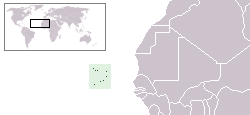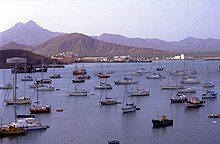Cape Verde
The Republic of Cape Verde or Cape Verde (Portuguese: Cabo Verde, pron. IPA /'ka.bu 'veɾ.d(ɨ)/) is a republic located on an archipelago in the Macaronesia ecoregion of the North Atlantic Ocean, off the western coast of Africa. The previously-uninhabited islands were discovered and colonized by the Portuguese in the 15th century; they subsequently became a trading centre for African slaves. Most Cape Verdeans descend from both groups.
"Cape Verde" is named for Cap-Vert, now in Senegal, the westernmost point of Africa.
República de Cabo Verde | |
|---|---|
| Motto: Unity, Work, Progress | |
| Anthem: Cântico da Liberdade | |
 | |
| Capital and largest city | Praia |
| Official languages | Portuguese (official) and nine Portuguese Creoles |
| Government | Republic |
| Independence | |
• Water (%) | Negligible |
| Population | |
• July 2005 estimate | 418,224 (164th) |
• 2001 census | 401,343 |
| GDP (PPP) | 2005 estimate |
• Total | $2.99 billion (171st) |
• Per capita | $5,858 (96th) |
| HDI (2003) | 0.721 high (105th) |
| Currency | Cape Verdean escudo (CVE) |
| Time zone | UTC-1 |
| Calling code | 238 |
| ISO 3166 code | CV |
| Internet TLD | .cv |
History
Main article: History of Cape Verde
Cape Verde was uninhabited when the Portuguese arrived in 1456, and the islands were thus made part of the Portuguese empire. Due to its location off the coast of Africa, Cape Verde became an important port, and was a major center of the slave trade.
In 1975, the islands achieved independence, partially due to the efforts of the African Party for the Independence of Guinea-Bissau and Cape Verde (PAIGC). After independence, the PAIGC attempted to unite Cape Verde and Guinea-Bissau into one nation, the PAIGC controlling both governments, but a coup in the latter nation in 1980 ended these plans. In Cape Verde itself the PAICV (affiliated with the PAIGC) governed until elections were held in 1991 that resulted in a change of government. The PAICV was re-elected in 2001.
External Links:
Politics
Main article: Politics of Cape Verde
The government of Cape Verde is based on a Constitution that was established in 1980. Elections are held for both the Prime Minister and President, who both govern for 5-year terms. Members of the General Assembly are elected as well, and they appoint the Supreme Court along with the President and Prime Minister.
See also: President of Cape Verde, National symbols
Geography
Main article: Geography of Cape Verde
Cape Verde is an archipelago off the coast of Africa at 15.02N, 23.34W. It is formed by 10 main islands and about 8 islets. The main islands are:
- Barlaventos (northern island group)
- Sotaventos (southern island group)
Of these, only Santa Luzia and the five islets are uninhabited. Presently it is a Natural Reserve. All islands are volcanic, but an active volcano exists on one of the islands, Fogo. See Mount Fogo.
Municipalities


Cape Verde is divided into 22 municipalities (municípios, singular - município):
- Santo Antão island:
- São Vicente island:
- Santa Luzia island (included in S. Vicente concelho)
- São Nicolau island:
- Sal island:
- Boa Vista island:
- Maio island:
- Santiago island:
- Fogo island:
- Brava island:
Economy
Main article: Economy of Cape Verde




Cape Verde is a small nation that lacks resources and has experienced severe droughts as well as water shortages. Agriculture is somewhat stymied by lack of rain, and is restricted to only four islands for most of the year. Most of the nation's GDP is from the services industry. Cape Verde's economy has largely grown since the late 1990s, and it is now considered a country of average human development. Cape Verde has significant cooperation with Portugal at every level of the economy, leading it to establish its currency, first as the Portuguese escudo, then as the euro since 1999.
Former Portuguese prime minister José Manuel Durão Barroso, now (second semester 2004) president of the European Commission, has promised to help integrate Cape Verde within the European Union sphere of influence via greater cooperation with Portugal. In March 2005, former Portuguese president Mário Soares launched a petition urging the European Union to start membership talks with Cape Verde.
Demographics
Main article: Demographics of Cape Verde
Most inhabitants of Cape Verde are descendants of the white Portuguese settlers and black African slaves. More Cape Verdeans live abroad than in Cape Verde, with significant emigrant Cape Verdean communities in the United States (264,900 Cape Verdians), Portugal (80,000) and Angola (45,000). There are also significant number of Cape Verdeans in São Tomé and Príncipe, Senegal, France, Brazil and the Netherlands.
Culture
Main article: Culture of Cape Verde
The culture of Cape Verde reflects its mixed Portuguese and African roots. It is well known for its diverse forms of music such as Morna (the Capeverdian Fado) and the urban Cape Verdian kizomba, and a wide variety of dances: the soft dance Morna, the Funana - a sensual mixed Portuguese and African dance, the extreme sensuality of coladeira (literally "glued"), and the African Batuque dance. These are reflective of the diverse origins of Cape Verde's residents. Indigenously, the term "Cabo" is used to refer to residents as well as the culture of Cape Verde.
- See also: List of writers from Cape Verde
- See also: List of painters from Cape Verde
Capeverdean Literature
Capeverdean literature is one of the richest of Lusitanian Africa.
- Poets: Frusoni Sergio, Tavares Eugénio, B.Léza, João Cleofas Martins, Luís Romano de Madeira Melo, Ovídio Martins, Barbosa Jorge, Fortes Corsino António, Baltasar Lopes (Osvaldo Alcântara), João Vário, Oswaldo Osório, Arménio Vieira, Vadinho Velhinho, José Luís Tavares, etc.
- Authors: Manuel Lopes - Movimento Claridade, Almeida Germano, Luís Romano de Madeira Melo, Germano de Almeida, Orlanda Amarilis, Jorge Vera Cruz Barbosa, Pedro Cardoso, Mário José Domingues, Daniel Filipe, Mário Alberto Fonseca de Almeida, Corsino António Fortes, Arnaldo Carlos de Vasconcelos França, António Aurélio Gonçalves, Aguinaldo Brito Fonseca, Ovídio de Sousa Martins , Osvaldo Osório, Dulce Almada Duarte, Manuel Veiga
- Poems in Portuguese: Capeverdean Poems, Poesia
- Capeverdean Literature
- Sopinha de Alfabeto
- Famous tales: Ti Lobo and Chibinho

Music
- Compositor: Manuel de Novas, Vasco Martins, Jorge Monteiro (Jotamonte), Frank Cavaquim (Francisco Vicente Gomes)
- Artist: Antoninho Travadinha, Bana, Bau, Gé Mendes, Bulimundo, Celina Pereira, Cesária Évora, Cordas do Sol, Fantcha, , Jorge Humberto, Ildo Lobo, Luís Morais, Lura, Maria-Alice, Orlando Pantera, Os Tubarões, Paulino Vieira, Simentera, Tchéka, Teofilo Chantre, Titina, Tito Paris,
Language
Portuguese is Cape Verde's official language, and the language of instruction in official schools. However, the Capeverdean Crioulo languages are also widely spoken. These are a range of Portuguese-based creole languages, which vary considerably from island to island.
There is a substantial body of literature in these languages, especially in the Crioulo of Santiago (bádiu) and the Crioulo of São Vicente (criol di de Soncente). The Crioulo languages have been gaining prestige since the nation's independence from Portugal, and there is a movement to make the variant of Santiago the official language of the country.
However, the substantial differences between the languages spoken in different islands, each with its traditional spelling system, has been a major obstacle in the way of this move. Some people have advocated the development of two unformized official languages: a North (Barlavento) standard, centered on the Crioulo of San Vicente, and a South (Sotavento) standard, centered on that of Santiago.
Newspapers
Newspapers:
- A Semana (Praia,1991-)
- Expresso das Ilhas
- Jornal O Cidadao (São Vicente)
- Jornal Horizonte (Praia, 1988-)
- Terra Nova (S.Vicente, 1975-)
- Artiletra (S.Vicente, 1991-)
Newspapers Online:
- VozDiPovo-Online :: A Voz + Jovem de Cabo Verde
- A Semana
- Infopress
- O Cidadao
- Paralelo 14
- Visão News
- O Liberal
- Expresso da Ilhas]
Miscellaneous topics
- Cape Verdean Immigration History in the United States
- Communications in Cape Verde
- Community of Portuguese Language Countries
- Foreign relations of Cape Verde
- Military of Cape Verde
- Public holidays in Cape Verde
- Transportation in Cape Verde
References
- Much of the material in these articles comes from the CIA World Factbook 2000 and the 2003 U.S. Department of State website.
- Dr Marcel Gomes Balla of Boston University has written a short history of these islands, Antonio's Island ISBN 1898030480, covering: The 'official' discovery of Cabo Verde, The Treaty of Tordesilhas- the complete text-in English, The Cape Verdean navigator who made an extraordinary impact on America, Africa, Europe and Asia, The involvement of the church with slavery, The historical ties between Cabo Verde and Columbus, Cabo Verde Vasco da Gama and Cabral, The creation of Brazil, The historical ties with Italy and other countries, The first non-Europeans to cross the Atlantic with a regular sailing schedule and a lot more useful information such as: Portraits of Cape Verdean navigators published for the first time for the public (Africans , mestizos, Europeans, but always Cape Verdeans). Still other famous Cape Verdeans in science, politics etc. Maps confirming the discovery of the islands and the importance of Cape Verdeans and Cabo Verde in world history.
External links
Government
- República de Cabo Verde official government site (in Portuguese)
- Assembleia Nacional de Cabo Verde official parliamentary site
News
- allAfrica.com - Cape Verde news headline links
Overviews
- BBC News - Country Profile: Cape Verde
- CIA World Factbook - Cape Verde
- Cabo Verde Chronological References
Directories
- LookSmart - Cape Verde directory category
- Open Directory Project - Cape Verde directory category
- Stanford University - Africa South of the Sahara: Cape Verde directory category
- The Index on Africa - Cape Verde directory category
- University of Pennsylvania - African Studies Center: Cape Verde directory category
- Yahoo! - Cape Verde directory category
- Cabo Verde 24 - Cape Verde directory category
Tourism



